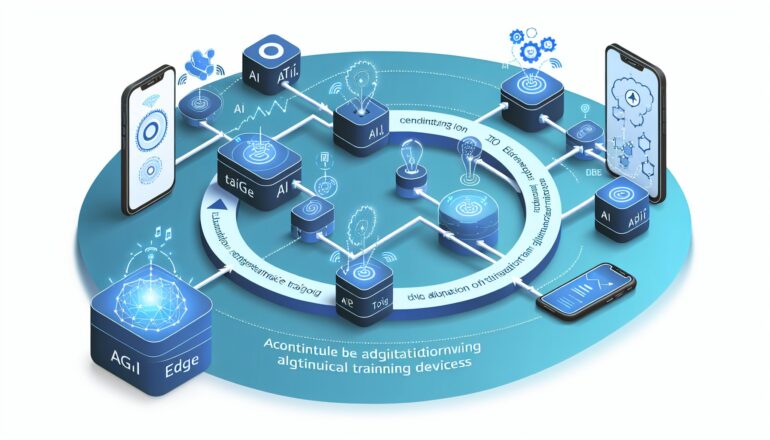TL;DR:
- Researchers from MIT and the MIT-IBM Watson AI Lab introduced PockEngine, an on-device AI training method.
- PockEngine enables efficient fine-tuning of deep-learning models directly on edge devices.
- It identifies and updates only crucial parts of the model, reducing computational overhead.
- PockEngine accelerates on-device training by up to 15 times without sacrificing accuracy.
- The technology has the potential to enhance privacy, lower costs, and support lifelong learning in AI applications.
Main AI News:
In the fast-paced world of artificial intelligence, the ability to continuously improve models is paramount. Personalized AI applications, from chatbots that adapt to user accents to smart keyboards that predict text based on typing history, rely on fine-tuning machine learning models with fresh data. However, traditional methods involve uploading user data to cloud servers, which not only consumes significant energy but also raises security concerns.
To address these challenges, researchers from MIT, in collaboration with the MIT-IBM Watson AI Lab and others, have pioneered a groundbreaking technique known as PockEngine. This innovative on-device training method empowers deep-learning models to adapt efficiently to new sensor data directly on edge devices. The key to PockEngine’s success lies in its ability to determine precisely which segments of a massive machine-learning model require updates for enhanced accuracy, thereby minimizing computational overhead and accelerating the fine-tuning process.
Compared to conventional approaches, PockEngine has demonstrated remarkable performance gains, achieving speeds up to 15 times faster on select hardware platforms. Notably, these efficiency gains come without sacrificing model accuracy. The researchers also observed that PockEngine’s fine-tuning method significantly improved the performance of a popular AI chatbot when it came to addressing complex questions.
Dr. Song Han, an associate professor in the Department of Electrical Engineering and Computer Science (EECS), a member of the MIT-IBM Watson AI Lab, a distinguished scientist at NVIDIA, and the senior author of the paper detailing PockEngine’s capabilities, emphasizes the transformative potential of this technology: “On-device fine-tuning can enable better privacy, lower costs, customization ability, and also lifelong learning, but it is not easy. Everything has to happen with a limited number of resources. We want to be able to run not only inference but also training on an edge device. With PockEngine, now we can.”
Ligeng Zhu, an EECS graduate student and the lead author of the paper, joins Dr. Han in showcasing the collaborative efforts of the research team from MIT, the MIT-IBM Watson AI Lab, and the University of California San Diego. Their findings were recently presented at the IEEE/ACM International Symposium on Microarchitecture.
PockEngine’s Approach: Layer by Layer
Deep-learning models are constructed using neural networks comprising multiple interconnected layers that process data to make predictions. During inference, data inputs are passed through these layers to produce predictions, and once processed, each layer no longer needs to be retained.
However, during training and fine-tuning, a process known as backpropagation occurs. This involves updating each layer as the model’s output gradually aligns with the correct answer. Storing these layers and intermediate results during fine-tuning becomes memory-intensive.
PockEngine takes advantage of this scenario by identifying which layers and portions thereof are vital for accuracy improvement. Not all layers require updates, and fine-tuning may not need to reach the first layer. By pinpointing these factors, PockEngine streamlines the fine-tuning process, reducing computational and memory requirements.
A Leaner Model for Enhanced Efficiency
Traditionally, the backpropagation graph is generated at runtime, entailing substantial computation. PockEngine takes a different approach, generating this graph during compile time while preparing the model for deployment. Unnecessary layers or portions are pruned, resulting in a streamlined model graph for runtime use. Additional optimizations are performed on this graph, further enhancing efficiency.
Since these actions occur only once, they significantly reduce computational overhead during runtime. Dr. Han likens it to careful planning before embarking on a hiking trip, ensuring an efficient and well-structured path to follow during execution.
Exceptional Performance Across Edge Devices
PockEngine’s impact extends beyond theoretical promise. When applied to deep-learning models on various edge devices, including Apple M1 Chips and common digital signal processors found in smartphones and Raspberry Pi computers, it consistently delivered on-device training speeds up to 15 times faster, all while maintaining model accuracy. Furthermore, PockEngine effectively reduced the memory requirements for fine-tuning.
The research team also applied PockEngine to the large language model Llama-V2, showcasing its effectiveness in handling complex language tasks. Models fine-tuned with PockEngine outperformed their counterparts, answering questions accurately and significantly speeding up the fine-tuning process.
Looking Ahead
The potential applications of PockEngine are vast, including fine-tuning even larger models designed to process text and images together. As the AI landscape continues to evolve, efficiency gains like those offered by PockEngine promise to shape the future of on-device AI training.
Ehry MacRostie, a senior manager in Amazon’s Artificial General Intelligence division, recognizes the significance of this research: “This work addresses growing efficiency challenges posed by the adoption of large AI models such as LLMs across diverse applications in many different industries. It not only holds promise for edge applications that incorporate larger models but also for lowering the cost of maintaining and updating large AI models in the cloud.” While not directly involved in this study, MacRostie collaborates with MIT on related AI research through the MIT-Amazon Science Hub, further underlining the broad potential impact of PockEngine in the AI ecosystem.
Conclusion:
The introduction of PockEngine represents a significant advancement in on-device AI training. It not only enhances the efficiency of fine-tuning processes but also opens doors for broader applications across various industries. This innovation holds the potential to revolutionize the market by offering better privacy, cost-effectiveness, customization, and the ability for lifelong learning, all within the constraints of limited resources found in edge devices. As AI models continue to grow in size and complexity, solutions like PockEngine will play a crucial role in shaping the future of AI deployment.

